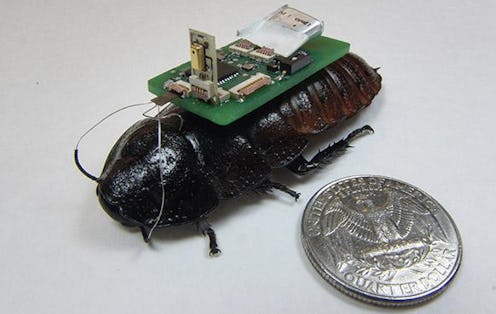News
It's Time To Rethink Your Cockroach Fears, Guys

In a surprising and not altogether welcome turn of events, cockroaches may soon elicit feelings of great relief as opposed to repulsion. Thanks to the miracle of science, researchers at North Carolina State University believe that they have turned the most hated pest into America into a potentially life-saving device. By attaching tiny backpacks onto the insects' backs, scientists are creating cyborg cockroaches that can rescue humans trapped in tight spaces. The day that we rejoice at the sight of a cockroach may soon be upon us.
These cockroaches, which will be remote controlled by their human counterparts, will be fully equipped with minuscule microphones that can relate high-resolution sound directly to first responders (who, for now, will still be human). This will allow rescuers to pinpoint the exact location of a person trapped in, say, a collapsed building, eliminating much of the time wasted on searching for victims. Dr. Alper Bozkurt of the North Carolina State University, who authored two papers on the biobot work, told The Atlantic, "In a collapsed building, sound is the best way to find survivors." Due to the the small size of cockroaches, they will be able to access tight spaces otherwise unreachable by even the smallest robots. Sorry, Apple, you'll never be able to make anything smaller than Mother Nature.
In an alternative version of the cyborg cockroach, fondly known as the biobots, researchers strap several three-directional microphones onto the insects' tiny backs, which automatically directs the biobots in the direction of the sound. By picking up distinct sounds, like a human cry for help, these cockroaches will travel towards areas of distress, aiding in the rescue process. Scientists believe that the cockroaches must work in teams to reach maximum effectiveness and efficiency, so if being trapped under a pile of debris doesn't sound enticing enough, just imagine your knight in shining armor as a swarm of remote-controlled roaches.
Of course, in order to maintain the biobots as a cohesive unit, scientists had to develop a sort of invisible fence technology to rein in the stragglers of the group. The fence is particularly useful in keeping the insects together, but is also meant to direct the roaches toward light sources so as to charge their solar-powered backpack. These biobots are the very definition of green technology — not only are the main vehicles 100 percent organic and biodegradable, but their fuel source is entirely renewable as well.
The idea is developed from last year's "RoboRoach" concept, which for the bargain price of $99, allowed homegrown scientists to experiment on their favorite crawly critters. The RoboRoach kit contained a set of electrodes that users could use to replace their pet cockroach's antenna. Sellers of the product urged consumers to anesthetize the roaches by dunking them in ice water, then removing its antennae before inserting electrodes into what remained of its sensors, then completing the process by supergluing a truly bizarre headset onto its head. For those with the patience to complete the time-consuming patience, they were rewarded with their very own remote-controllable roach, whose brains could be stimulated with a three-volt shock to move in any desired direction.
These biobots use similar technology, but instead of using shocks and electrodes, scientists have employed the use of tiny microphones that stimulate cockroaches' sensory organs, which "encourages" them to move in a particular direction. This is certainly a more humane method of generating movement, and will be less likely to incur the wrath of PETA, which attempted to stop the sale of RoboRoach's in 2013. The animal rights organization was horrified by the science experiment, saying, "There is no way a child is going to learn anything about neurological diseases or be interested in studying it in the future based on mutilating a cockroach." Greg Gage, the co-founder of the company that manufactured the RoboRoach, responded, "We’re not breaking any laws...These are roaches that people would easily kill in their apartments."
But biobots would not be the sorts of roaches that humans would want to kill — after all, with their bionic qualities, they may indeed become our saviors. But as exciting as this latest biological development may be, the biobots have not yet been perfected, as they are currently incapable of distinguishing between important — that is to say, human — sound, and unimportant sounds, like leaky pipes or crashing debris. Once scientists iron out this particular kink, they will be able to "use the biobots equipped with microphone arrays to zero in on where those sounds are coming from," said Bozkurt.
So what is it about cockroaches in particular that have made them such a popular guinea pig for scientists? In the case of the biobots, it is the cockroaches extreme resilience to a host of both natural and manmade phenomena that makes them ideal candidates for dangerous situations. That famous apocalypse situation in which the only living creatures are a bunch of roaches was not created purely to worsen your phobia of insects, but is rather founded upon scientific truth. When Mythbusters tested the effects of radiation on cockroaches, they found that "10 percent could survive Hiroshima-level radioactive rays after 30 days of exposure."
Moreover, cockroaches have an almost unmatchably high rate of adaptation, making them some of the hardiest living creatures in the world. Over the course of just a few generations, they are able to "tweak their internal chemistry" to avoid toxins, and pass along this trait to their progeny, allowing for the continued survival of the species. If that's not enough, roaches can also survive without their heads and can hold their breath for up to seven minutes at a time. Oh, and the female roaches? They don't need males to reproduce. Honestly, if humans were more like cockroaches, we'd be doing much better on this planet.
Images: UMengineering, brealtv, CAArmbruster/Twitter